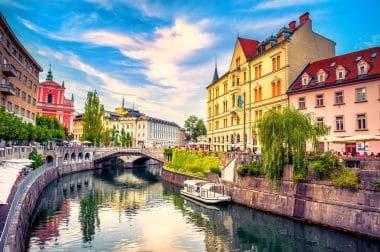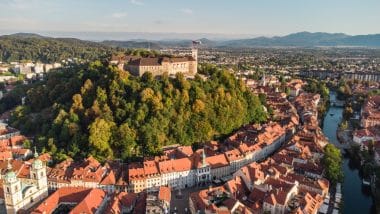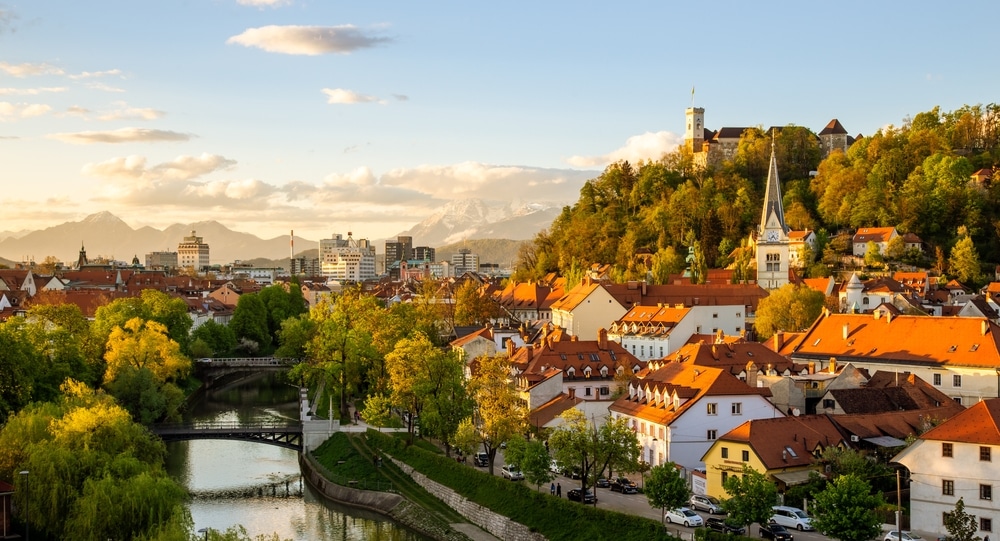The alleys of the old town tell stories that date back to the Romans. The baroque houses are magnificent and the bells ring over from St. Nicholas Cathedral. Under the Zmajski most, the Dragon Bridge, the Ljubljanica rushes. On Tivoli Street rises the Orthodox Church of Cyril and Methodius. Ljubljana, the capital of Slovenia, is a gem with many facets. Rich cultural heritage meets scenic beauty and culinary sophistication. A city trip lasting several days is worthwhile.
The Dragon of Ljubljana – an ancient myth with consequences

The city’s coat of arms is adorned with a dragon. He stands for wisdom and strength and is considered a vigilant patron saint. In the streetscape, it appears again and again on the manhole covers and it adorns the city’s most famous bridge several times. Built around 1900 as the Emperor Franz Joseph Jubilee Bridge, winged lions were initially planned for the bridge construction, but then came the dragons.
The armoured monster plays an inglorious role in the legend. The dragon threatened ancient Ljubljana and demanded that people be eaten. If he didn’t get it, he burned down the city in one breath. Only the legendary hero Jason freed Ljubljana from this plague. Today, the dragon Ljubo is a sought-after souvenir as the mascot of the city.
The 5 most beautiful sights of Ljubljana
The Austrian influence on the city’s architecture is unmistakable. Charmingly, the baroque buildings invite you to stop. Until 1918, Ljubljana belonged to Austria-Hungary, later to the Kingdom of Yugoslavia, then briefly to Italy and finally to the Federal Republic of Yugoslavia, until it finally gained independence in 1991. If you wander through the city with an attentive eye, you will discover the traces of time.
The 5 most beautiful sights of Ljubljana include:
- the 900-year-old Ljubljana Castle, which can be reached by cable car
- the baroque town hall, which can be visited on guided tours
- the Tivoli Park, which was laid out in 1813 according to plans by the engineer Jean Blanchard, includes the zoo and is now a nature reserve
the Cathedral of St. Nicholas goes back to plans by the Roman Jesuit Andrea Pozzo
the Slovenian National Gallery, a neo-Renaissance building that houses an important collection
A city for connoisseurs

“Odprta kuhna” means something like “open kitchen”. The market is open every Friday from spring to autumn in good weather. It offers the best opportunities to familiarize yourself with Ljubljana and the whole of Slovenia in culinary terms. Here, restaurants and cafés offer specialties to go.
Kebab and roasted lamb, fish and seafood, delicious braised vegetable dishes invite you to enjoy. The visit ends with a coffee and delicious tartlets. You should try the potica, a nut roll, and of course the “Torta Ljubljana”, a buckwheat sponge cake. First of all, you should take a look at wine and rakija.
The Balkans, Turkish cuisine, Italy and Austria have influenced the cuisine of Slovenia. Great importance is attached to freshness. Regional food is preferred. The best way to get to know the cuisine is in the traditional taverns. Anchovy na žaru, grilled sardines with lots of garlic, taste particularly good there.
Hiking near the capital
Slovenia is considered a hiking paradise. The capital Ljubljana is right in the middle of it. Hills and forests surround the urban space. The Ljubljanica flows into the Sava. The view of the Kamnik-Savinja Alps and the Karawanks is magnificent. Across Tivoli Park, we head out to Tošč. The 1021-metre-high mountain is easy to climb. Dense forests provide shade.
A trip to the village of Topol leads to the vicinity of Sveti Jakob, which is more of a small mountain at just under 806 meters. A highlight is a visit to St. James’ Church from the 16th century. In clear weather you can see Triglav from Sveti Jakob. It is the highest mountain and one of the most important landmarks in Slovenia.
Where to go in Ljubljana in the evening?
An evening in Ljubljana can be arranged according to taste and preferences. A meal in the restaurant can be followed by a stroll through the old town. The extensive pedestrian zone begins at Kongresni Trg. Ljubljanski Grad, the castle of Ljubljana, is illuminated at night, as are the university, philharmonic hall and other sights. The restaurants and bars are particularly beautiful on the Ljubljanica, the river. It is not far from there to the Tromostovje, the three-horse bridge.
If you like it more spirited, visit one of the numerous clubs. The artists’ quarter of Metelkova is known for its nightlife. The former barracks is now used by artists. There are various discos, bars and cafés. Exciting concerts and events always take place here.
When is the best time to visit Ljubljana?
You can travel to the easily accessible capital of Slovenia all year round. Spring and autumn are best suited for sightseeing. The temperatures are moderate during this time and not too high. This makes strolling pleasant.
How to get to Ljubljana from Germany?
There are many ways to get to Ljubljana from Germany. The fastest and most comfortable way is, of course, by plane. But there are also alternatives:
- Plane: Ljubljana Airport (LJU) is served by various airlines, including Germany. Direct flights might be available in Germany depending on your departure city, and the flight time is relatively short.
- Train: There are train services from Germany to Ljubljana, but they usually involve at least one change, often in Austria or other neighboring countries. Travel time may vary depending on the starting point and connection, but it’s a scenic and eco-friendly option.
- Bus: Various bus companies offer direct and indirect routes from German cities to Ljubljana. Bus travel can be a cost-effective alternative, although it usually takes longer than air travel. Bus lines to neighboring countries: Trieste, Venice (Mestre, Marco Polo Airport), Florence, Milan, Klagenfurt, Vienna, Munich, Dortmund, Paris, Budapest, Zagreb, Sarajevo, Belgrade, Niš, Sofia.
- Car: By car, it is of course possible to drive to Ljublijana on your own paths. The duration of the trip depends on the starting point in Germany and the routes chosen. Keep in mind that a vignette is required to use motorways in Slovenia. Class 2A (cars and motorhomes)
- Annual vignette: 110,00 €
- 6-month vignette: 30,00 €
- Weekly vignette: 15.00 €
Class 2B (vehicle height 1.30, measured above the front axle, or higher)
- Annual vignette: 220,00 €
- 6-month vignette: 60,00 €
- Weekly vignette: 30.00 €
Class A (single-track vehicles)
- Annual vignette: 55.00 €
- 6-month vignette: 30,00 €
- Weekly vignette: 7.50 €


